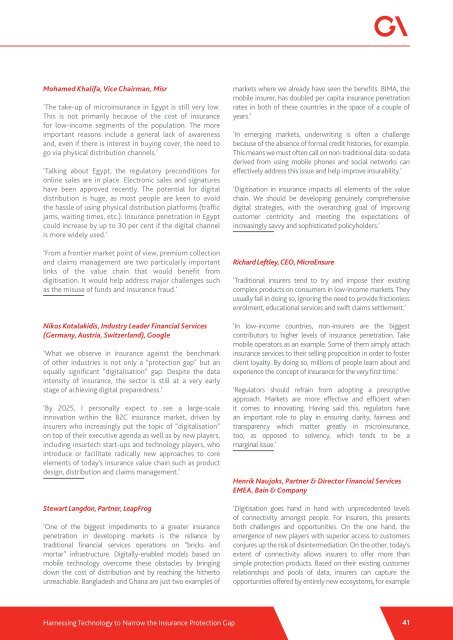Harnessing Technology to Narrow the Insurance Protection Gap
harnessing-technology-to-narrow-the-insurance-protection-gap
harnessing-technology-to-narrow-the-insurance-protection-gap
You also want an ePaper? Increase the reach of your titles
YUMPU automatically turns print PDFs into web optimized ePapers that Google loves.
Mohamed Khalifa, Vice Chairman, Misr<br />
‘The take-up of microinsurance in Egypt is still very low.<br />
This is not primarily because of <strong>the</strong> cost of insurance<br />
for low-income segments of <strong>the</strong> population. The more<br />
important reasons include a general lack of awareness<br />
and, even if <strong>the</strong>re is interest in buying cover, <strong>the</strong> need <strong>to</strong><br />
go via physical distribution channels.’<br />
‘Talking about Egypt, <strong>the</strong> regula<strong>to</strong>ry preconditions for<br />
online sales are in place. Electronic sales and signatures<br />
have been approved recently. The potential for digital<br />
distribution is huge, as most people are keen <strong>to</strong> avoid<br />
<strong>the</strong> hassle of using physical distribution platforms (traffic<br />
jams, waiting times, etc.). <strong>Insurance</strong> penetration in Egypt<br />
could increase by up <strong>to</strong> 30 per cent if <strong>the</strong> digital channel<br />
is more widely used.’<br />
‘From a frontier market point of view, premium collection<br />
and claims management are two particularly important<br />
links of <strong>the</strong> value chain that would benefit from<br />
digitisation. It would help address major challenges such<br />
as <strong>the</strong> misuse of funds and insurance fraud.’<br />
Nikos Kotalakidis, Industry Leader Financial Services<br />
(Germany, Austria, Switzerland), Google<br />
‘What we observe in insurance against <strong>the</strong> benchmark<br />
of o<strong>the</strong>r industries is not only a “protection gap” but an<br />
equally significant “digitalisation” gap. Despite <strong>the</strong> data<br />
intensity of insurance, <strong>the</strong> sec<strong>to</strong>r is still at a very early<br />
stage of achieving digital preparedness.’<br />
‘By 2025, I personally expect <strong>to</strong> see a large-scale<br />
innovation within <strong>the</strong> B2C insurance market, driven by<br />
insurers who increasingly put <strong>the</strong> <strong>to</strong>pic of “digitalisation”<br />
on <strong>to</strong>p of <strong>the</strong>ir executive agenda as well as by new players,<br />
including insurtech start-ups and technology players, who<br />
introduce or facilitate radically new approaches <strong>to</strong> core<br />
elements of <strong>to</strong>day’s insurance value chain such as product<br />
design, distribution and claims management.’<br />
Stewart Langdon, Partner, LeapFrog<br />
‘One of <strong>the</strong> biggest impediments <strong>to</strong> a greater insurance<br />
penetration in developing markets is <strong>the</strong> reliance by<br />
traditional financial services operations on “bricks and<br />
mortar” infrastructure. Digitally-enabled models based on<br />
mobile technology overcome <strong>the</strong>se obstacles by bringing<br />
down <strong>the</strong> cost of distribution and by reaching <strong>the</strong> hi<strong>the</strong>r<strong>to</strong><br />
unreachable. Bangladesh and Ghana are just two examples of<br />
markets where we already have seen <strong>the</strong> benefits. BIMA, <strong>the</strong><br />
mobile insurer, has doubled per capita insurance penetration<br />
rates in both of <strong>the</strong>se countries in <strong>the</strong> space of a couple of<br />
years.’<br />
‘In emerging markets, underwriting is often a challenge<br />
because of <strong>the</strong> absence of formal credit his<strong>to</strong>ries, for example.<br />
This means we must often call on non-traditional data: so data<br />
derived from using mobile phones and social networks can<br />
effectively address this issue and help improve insurability.’<br />
‘Digitisation in insurance impacts all elements of <strong>the</strong> value<br />
chain. We should be developing genuinely comprehensive<br />
digital strategies, with <strong>the</strong> overarching goal of improving<br />
cus<strong>to</strong>mer centricity and meeting <strong>the</strong> expectations of<br />
increasingly savvy and sophisticated policyholders.’<br />
Richard Leftley, CEO, MicroEnsure<br />
‘Traditional insurers tend <strong>to</strong> try and impose <strong>the</strong>ir existing<br />
complex products on consumers in low-income markets. They<br />
usually fail in doing so, ignoring <strong>the</strong> need <strong>to</strong> provide frictionless<br />
enrolment, educational services and swift claims settlement.’<br />
‘In low-income countries, non-insurers are <strong>the</strong> biggest<br />
contribu<strong>to</strong>rs <strong>to</strong> higher levels of insurance penetration. Take<br />
mobile opera<strong>to</strong>rs as an example. Some of <strong>the</strong>m simply attach<br />
insurance services <strong>to</strong> <strong>the</strong>ir selling proposition in order <strong>to</strong> foster<br />
client loyalty. By doing so, millions of people learn about and<br />
experience <strong>the</strong> concept of insurance for <strong>the</strong> very first time.’<br />
‘Regula<strong>to</strong>rs should refrain from adopting a prescriptive<br />
approach. Markets are more effective and efficient when<br />
it comes <strong>to</strong> innovating. Having said this, regula<strong>to</strong>rs have<br />
an important role <strong>to</strong> play in ensuring clarity, fairness and<br />
transparency which matter greatly in microinsurance,<br />
<strong>to</strong>o, as opposed <strong>to</strong> solvency, which tends <strong>to</strong> be a<br />
marginal issue.’<br />
Henrik Naujoks, Partner & Direc<strong>to</strong>r Financial Services<br />
EMEA, Bain & Company<br />
‘Digitisation goes hand in hand with unprecedented levels<br />
of connectivity amongst people. For insurers, this presents<br />
both challenges and opportunities. On <strong>the</strong> one hand, <strong>the</strong><br />
emergence of new players with superior access <strong>to</strong> cus<strong>to</strong>mers<br />
conjures up <strong>the</strong> risk of disintermediation. On <strong>the</strong> o<strong>the</strong>r, <strong>to</strong>day’s<br />
extent of connectivity allows insurers <strong>to</strong> offer more than<br />
simple protection products. Based on <strong>the</strong>ir existing cus<strong>to</strong>mer<br />
relationships and pools of data, insurers can capture <strong>the</strong><br />
opportunities offered by entirely new ecosystems, for example<br />
<strong>Harnessing</strong> <strong>Technology</strong> <strong>to</strong> <strong>Narrow</strong> <strong>the</strong> <strong>Insurance</strong> <strong>Protection</strong> <strong>Gap</strong><br />
41


